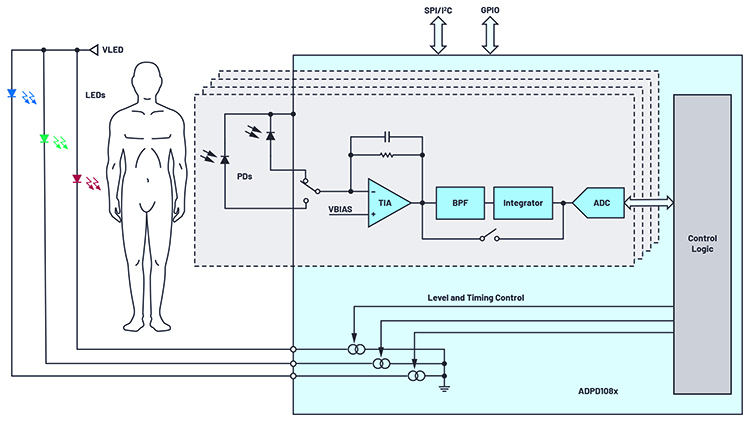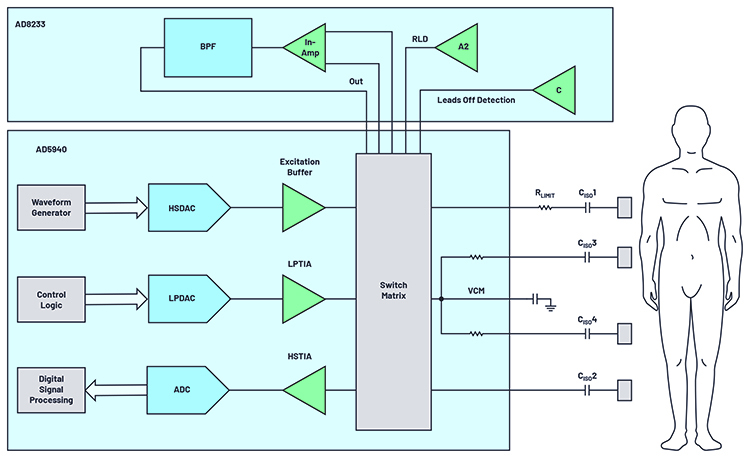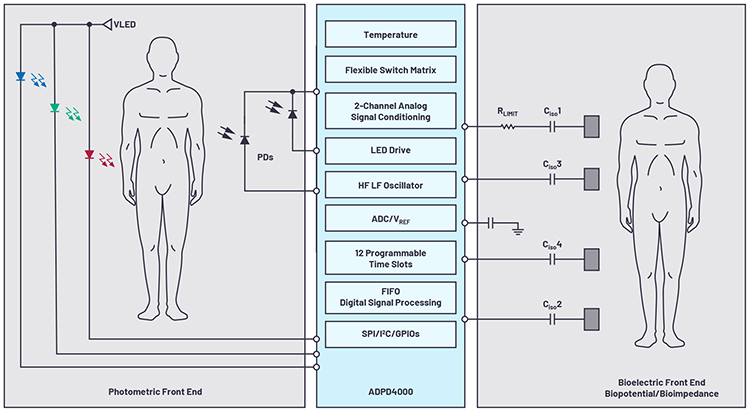Vital sign technology: condition-based monitoring of the human body
Vital sign monitoring has extended beyond the boundaries of medical practice and into many areas of our everyday lives. Advances in microelectronics have led to cost reduction in monitoring systems, making these technologies more accessible and common in areas such as telemedicine, sports, fitness and wellness, and workplace safety, as well as the automotive market. Despite this expansion and given the health-related nature of these applications, quality standards remain high. Cosimo Carriero, Field Applications Engineer, at Analog Devices (ADI), investigates.
Monitoring vital signs involves measuring a series of physiological parameters that can give an indication of the health of an individual. Heart rate is one of the most common parameters, and it can be detected via an electrocardiogram, which measures the frequency of the heartbeat and, above all, its variations. Changes in heart rate tend to be based on activity. During sleep or when resting, the rhythm is slower, but tends to increase following physical activity, an emotional response, stress, or anxiety.
A heart rate that falls outside the normal range may indicate the presence of a disorder such as bradycardia (when the heart rate is too low) or tachycardia (when it is too high). Breathing is another key vital sign. The oxygenation level of the blood can be measured using a technique called photoplethysmography (SpO2). Poor oxygenation can be related to the onset of diseases or disorders affecting the respiratory system.
Other vital sign measurements that can provide indications as to a person’s physical condition are blood pressure, body temperature, and skin conductance response. Skin conductance response, also known as electrodermal response, is closely linked to the sympathetic nervous system, which in turn is directly involved in the regulation of emotional behaviours. Measuring skin conductance provides indications as to the stress, fatigue, mental state, and emotional response of a patient. Additionally, measuring body composition, the percentages of lean mass and fat mass, and the degree of hydration and nutrition provides clear indications as to a person’s clinical status. Lastly, measuring motion and posture can provide useful information on the activity of the subject.
Technologies for measuring vital signs
In order to monitor vital signs such as heart rate, breathing, blood pressure and temperature, skin conductance, and body composition, various sensors are required and solutions must be compact, energy efficient, and reliable. Vital sign monitoring includes:
- Optical measurements
- Biopotential measurements
- Impedance measurements
- Measurements using MEMS sensors
Optical Measurements
Optical measurements go beyond standard semiconductor technology. In order to take this type of measurement, an optical measurement toolbox is required. Figure 1 shows a typical signal chain for optical measurements. Light sources (generally LEDs) are needed to generate a light signal, which may consist of different wavelengths. The combination of several wavelengths allows for greater measuring precision. A series of silicon or germanium sensors (photodiodes) are also required to transform the optical signal into an electrical signal, also known as the photocurrent.
Photodiodes must respond to the wavelength of the light source with enough sensitivity and linearity. The photocurrent must then be amplified and converted, hence the need for a high performance, energy efficient, multichannel analogue front end that can control the LEDs, amplify and filter the analogue signal, and perform analogue-to-digital conversion with the necessary resolution and accuracy.

Above: Figure 1. Signal chain for optical measurements
Packaging of the optical system also plays a fundamental role. The package is not only a container, but also a system with one or more optical windows that can filter outgoing and incoming light, without excessive attenuation or reflections that could compromise the integrity of the signal. The optical system package must also accommodate multiple devices including LEDs, photodiodes, and analogue and digital processing chips in order to create a compact multichip system.
Finally, a coating technology that enables the creation of optical filters is also essential to select the portion of the spectrum that is required for the application and eliminate unwanted signals. The application must function even when exposed to sunlight. If no optical filter is present, the magnitude of the signal could saturate the analogue chain, thus preventing the electronics from functioning properly.
Analog Devices offers a family of photodiodes and various analogue front-ends capable of processing the signal received from the photodiodes and controlling the LEDs. A full optical system is also available, which incorporates LEDs, photodiodes, and front ends into a single device, for example, the ADPD1081.
Biopotential and bioimpedance measurements
A biopotential is an electrical signal generated by the effect of the electrochemical activity in our body. Examples of biopotential measurements include the electrocardiogram (ECG) and the electroencephalogram. These detect very low magnitude signals in a frequency band where there are several interferents. As a result, the signal must be amplified and filtered before being processed. ECG biopotential measurements are widely used in vital sign monitoring, and Analog Devices offers several components for this task including the AD8233, the ADAS1000 chip family, and the ADuCM3029.
The AD8233 is designed for wearable applications and can be combined with the ADuCM3029, a system on a chip (SoC) based on Cortex-M3 technology, to create a complete system. Additionally, the ADAS1000 family, designed for higher end applications, is characterised by low energy consumption. It is particularly suitable for battery powered portable devices and it is scalable in terms of power and noise (that is, the noise level can be reduced with a proportional increase in power consumption), making it a great integrated solution for ECG systems.
Bioimpedance is another measurement that can give us useful information on our physical state. Impedance measurements provide information regarding our electrodermal activity, the composition of our body, and our state of hydration. Each parameter requires a different measurement technique. The number of electrodes required for each one and the point at which they are applied may vary along with the range of frequencies used.

Above: Figure 2. A complete bioelectric system with biopotential and bioimpedance measurement
For example, low frequencies (up to 200Hz) are used when measuring the impedance of the skin, whereas for human body composition, a fixed frequency of 50kHz is usually used. Likewise, varying frequencies are used to measure hydration and to correctly evaluate the intracellular and extracellular fluids.
Although the techniques may differ, a single front end, the AD5940, can be used for all bioimpedance and impedance measurements. This device provides the excitation signal and the complete impedance measurement chain. Various frequencies can be generated to fulfil multiple measurement requirements. In addition, the AD5940 is designed to work with the AD8233 to create a comprehensive bioimpedance and biopotential reading system, as shown in Figure 2. Other devices for impedance measurement include the ADuCM35x family of SoC solutions, which, in addition to the dedicated analogue front end, offer a Cortex-M3 microcontroller, memory, HW accelerators, and communication peripherals for electrochemical sensors and biosensors.
Motion measurements using MEMS sensors
Since MEMS sensors can detect gravitational acceleration, they can be used to detect activity and anomalies such as an unsteady gait, a fall or a concussion, or even monitor posture when a subject is at rest. In addition, MEMS sensors can be used to supplement optical sensors, as those are subject to movement artefacts. When this occurs, the information from the accelerometer can be used to make a correction. The ADXL362 is one of the most popular devices in the medical field and is the 3-axis accelerometer with the lowest energy consumption on the market. It is characterised by a programmable measurement range from 2g to 8g and a digital output.
ADPD4000
Wearable devices currently available on the market, such as smart bracelets and smart watches, come with various functions for monitoring vital signs. Among the most common are heart rate monitors, pedometers, and calorie counters. Blood pressure and body temperature are also often measured, along with electrodermal activity, changes in blood volume (via photoplethysmography), and other metrics. As the number of monitoring options grows, so does the need for highly integrated electronic components. The ADPD4000 features an extremely flexible architecture and was created to help designers meet this need. It can manage a photometric front end, pilot LEDs, and read photodiodes in addition to providing biopotential and bioimpedance readings.

Above: Figure 3. ADPD4000 for photometric, biopotential, bioimpedance, and temperature measurements
The ADPD4000 is equipped with a temperature sensor for compensation and a switch matrix, which enables the necessary outputs to be piloted and the signals to be acquired, either for single-ended or differential voltage signals. The output is selectable and could be single-ended or differential depending on the input requirements of the ADC to which the ADPD4000 is connected. The device can be programmed with 12 different time bands, each dedicated to processing a specific sensor. Figure 3 summarises the key characteristics of the ADPD4000 in a few typical applications.
Conclusion
With advances in technology, vital sign monitoring will become increasingly common in various industries and throughout our daily lives. Whether used for treatment or prevention, such health-related solutions call for reliable and robust technology.



